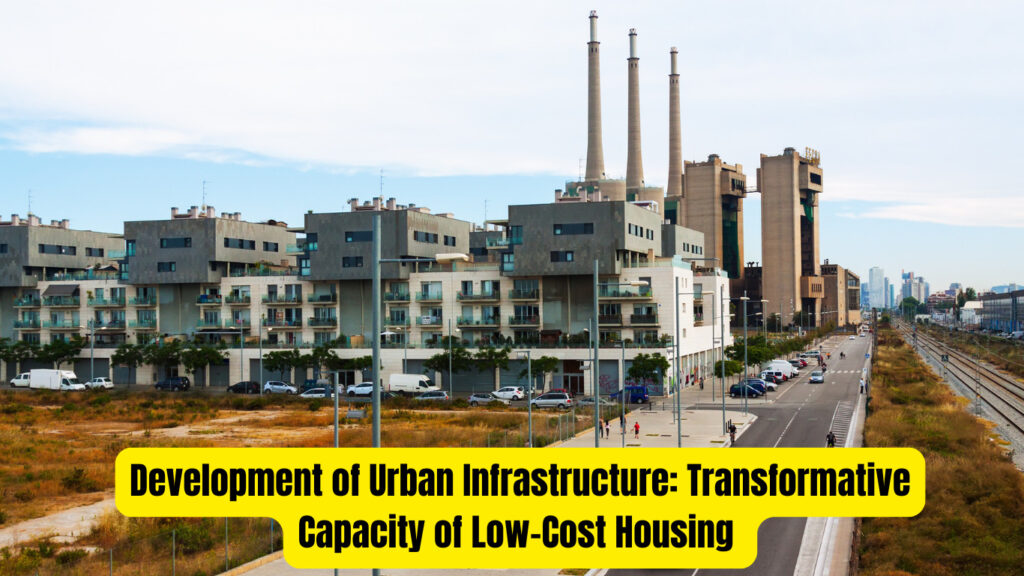
Development of Urban Infrastructure: Transformative Capacity of Low-Cost Housing and Sanitation Infrastructure
Development in urban infrastructure would provide a strong foundation for sustainable growth for cities. Sanitation and housing demands, which implore better availability for affordable solutions, come at an appropriate hour against the background of rising urbanization levels worldwide and acutely across India. In the last few years, governments have presented landmark investment plans to modernize urban housing and drainage facilities to achieve wholesome access by one and all. The blog post highlights some of the critical aspects of urban infrastructure development, including affordable housing and improved sanitation, and their transformative impact on city life.
Table of Contents
Importance of Urban Infrastructure Development
Urban centers have become centers of economic activities, including businesses and industries, where most persons live. Fast urbanization has also introduced problems in the form of shortages of houses, poor sanitation systems, and environmental degradation. Strategic investments in infrastructural development can reap the following benefits:
1. Improvement in the quality of life: Affordable housing and sanitation systems are sure ways to ensure quality living standards for all, reducing risks and improving general health.
2. Encourage Economic Development: The infrastructure which is efficient attracts investment, generates employment, and encourages economic activities .
3. Be Sustainable: Green urbanization in the form of sustainable housing and water-conserving sanitation systems minimize the effects of the city on the environment .
Bihar’s Digital Learning Platforms for students: The Transformatory Initiative
Affordable Housing: A Basic Requirement of the Urban Dwellers
Affordable housing becomes an important component in urban infrastructure development. Affordable housing refers to that kind of housing that is fiscally accessible to the poor from all income brackets, especially low-and middle-income people. Key objectives include:
1. Address Housing Deficit: Housing deficits have led to staying in slums and informal settlements as a result of rapid migration into cities.
2. Reducing Inequality: Affordable housing offers all citizens residing in the urban area the proper accommodation meeting safety and security requirements irrespective of the economic status of a citizen.
3. Promotion of Home Ownership: Policies for affordable housing give clear encouragement for owning homes, and it eventually leads to the financial security of a citizen.
Government Measures to Provide Affordable Housing
In other parts of the world, a variety of plans and schemes abound in terms of housing problems. To cite an example, India’s urban Pradhan Mantri Awas Yojana initiative, aside from millions of houses, would ensure the availability of affordable homes with all amenities. All other countries have parallel schemes offering incentives in terms of subsidies, tax holidays, and public-private partnerships that speed up the housing program .
Innovative Approaches in Affordable Housing
1. Public-Private Partnerships: Public-Private Partnerships allow houses to be built considering affordability.
2. Ecological Housing Projects: Using ecological material and energy-safe designs of buildings reduces the environmental costs incurred as well.
3. Rental Housing Models: Rental housing schemes have the scope for the affordability of mobile groups of migratory workers and students.
Sanitation Infrastructure: The Outcome Ensures Clean, Healthy Cities
Sanitation and drainage have always proved efficient in maintaining hygiene, preventing diseases, and bettering the conditions of urban living. Some of the key objectives are:
1. Prevention of Waterlogging and Flood: Modern drainage does not allow waterlogging or flooding to occur in the event of heavy falls. This protects life and property.
2. Safeguard Health Hazards: Proper management of waste and sewage helps prevent the spreading of diseases like cholera and dengue.
3. Environmental Sanitation: Waste collection is carried out through biodegradable means and water recycling is done in an environmental friendly process; less pollution and optimum usage of resources.
Problems in Urban Sanitation
Most of the problems are faced by the infrastructure of urban sanitation despite great success:
-Aged and inadequate drainage network within the older cities.
-Growth has peaked their systems.
-No money or experts for revitalizing infrastructure.
Wastewater purification and treatment solutions
1. Intelligent drainage system: Sensors based on the Internet of things, which will observe the performance of the drainage and causes ensuing in blockages; timely maintenance is ensured.
2. Decentralized wastewater treatment: Load on the central facility is reduced, and water reuse is ensured through treatment at the community level.
3. Awareness Campaigns: Citizens will be sensitized about proper waste disposal and methods toward saving water for the sustainability motive.
Role of Technology in Urban Infrastructure
Well, certainly, technology is the primary driving force for infrastructure growth in urban areas. For instance, from smart house designs to AI-driven drainage management, the list of technological innovations sure revamps cities around. A few of the significant developments are as follows:
– Geospatial Mapping: Identification of interventions for filling up the housing and sanitation gap
– Smart Sensors: Water usage monitoring and the effective draining system
– Sustainable Construction Techniques: Application of 3D printing and prefab modules, which will allow for quicker construction at a cheaper cost.
Economic and Social Considerations of Infrastructure Development
Investment in urban housing and sanitation has far-reaching impacts on economic and social considerations
1. Creates employment: Direct engagement of all sectors in the project sites involving construction work.
2. Better public health: Improvement in sanitation reduces healthcare costs and increases productivity.
3. Social equity: Housing for the low-income groups promotes inclusiveness and social equity.
Case Studies : Success Stories in Urban Development
1. Singapore Public Housing Programme: HDB in Singapore provides affordable housing to more than 80% of the population and maintains high living standards.
2. Slum Redevelopment Scheme in Mumbai: Rehousing slum areas through modernized housing complexes has thus enhanced their quality of life.
3. Netherlands’ Advanced Drainage Systems: For example, in the Netherlands, advanced techniques used in the flood management process have made the city environment comparatively safer.
Trends in Urban Infrastructure Development in the Future
Infrastructure development and changes must be in tune with the changing dynamics of a city, taking in the challenges and opportunities ready to emerge into the picture. Future trends:
1. Sustainable Urban Planning: The city should be designed with green spaces, renewable energy, and efficient transport systems.
2. Affordable Smart Housing: With the capabilities of technology, smart homes can be made available to all economic segments.
3. Resilient Drainage Systems: Cities should prepare themselves to combat climate change impacts such as sea level rise and extreme weather systems.
Conclusion
Indeed, appropriate urban infrastructural development-oriented toward affordable housing and sanitation systems-is the key area for producing sustainable, livable cities. Housing shortages along with poor sanitation reduce the quality of life, inequalities, and economic growth. Indeed, a whole innovative approach and robust policies can even make urban centers models for inclusivity and resilience toward a future brimming with hope.





1 thought on “Development of Urban Infrastructure: Transformative Capacity of Low-Cost Housing and Sanitation Infrastructure”